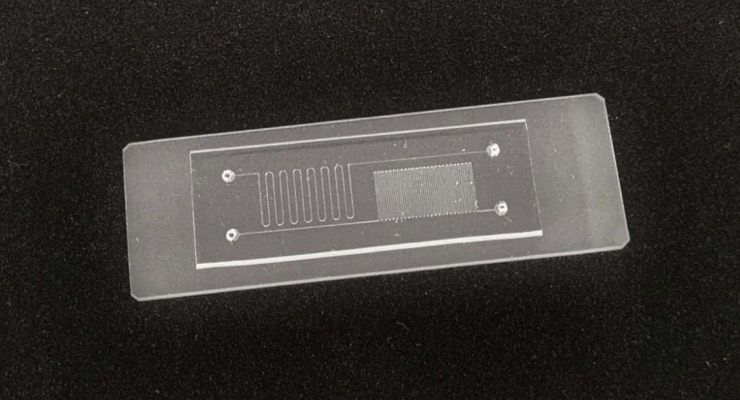Photolithography is a fundamental technology that Toppan has perfected for more than 60 years in the electronics industry and is used in the microfabrication of LCD displays and masterplates for semiconductor circuits. The microfluidic chips made by this technology are expected to be used in the fields of in vitro diagnostics and liquid biopsy (a largely non-invasive diagnostic technology requiring only a small amount of blood or other liquid sample), which is expected to experience high levels of demand for applications including cancer diagnostics and clinical testing.
In recent years, there has been an increasing interest in liquid biopsy tests, which use samples of blood or other fluids to allow ultra-early detection of cancer. Microfluidic chips made by injection molding using PDMS are widely used for testing due to the excellent biocompatibility of the material and its suitability for optical analysis. The low productivity of microfabrication when using PDMS and the high cost of liquid silicone as a raw material, however, drives up the cost of the chips, hindering more widespread use.
To meet this challenge, Toppan has developed a technology for producing microfluidic chips by applying microfabrication technology based on photolithography techniques cultivated in the manufacture of ACL color filters.
More specifically, channels (grooves or holes allowing the flow of liquid or gas) with a width of 10 micrometers (micrometer = 0.001 millimeter) to several millimeters and a depth of one to 50 micrometers are formed on a resin photosensitive (photosensitive material) applied to a glass substrate. A cover with openings for injecting samples or fluid samples is then applied to the cured photosensitive resin.
Microfluidic chips manufactured using this method have properties equivalent to or better than PDMS chips and can enable higher volume production at lower cost.
“We have applied Toppan’s advanced microfabrication techniques to potentially enable mass production of something that can lead to widespread use of medical testing techniques that reduce patient burden,” said Yuichiro Abe, head of planning of development in Toppan’s electronics division. “We will continue to work with our collaborative partners on pilot tests for the commercialization of glass microfluidic chips and hope to establish photolithography-based mass production technology by March 2022.”






More Stories
Delay in mass production of new Intel products is a boon for AMD, share of AMD x86 server processors expected to exceed 22% in 2023, according to TrendForce
Quantum industry milestone brings mass production of quantum chips closer
NEO Battery Materials provides updates on installation of additional equipment for mass production optimization and final stages of commercial plant design for construction